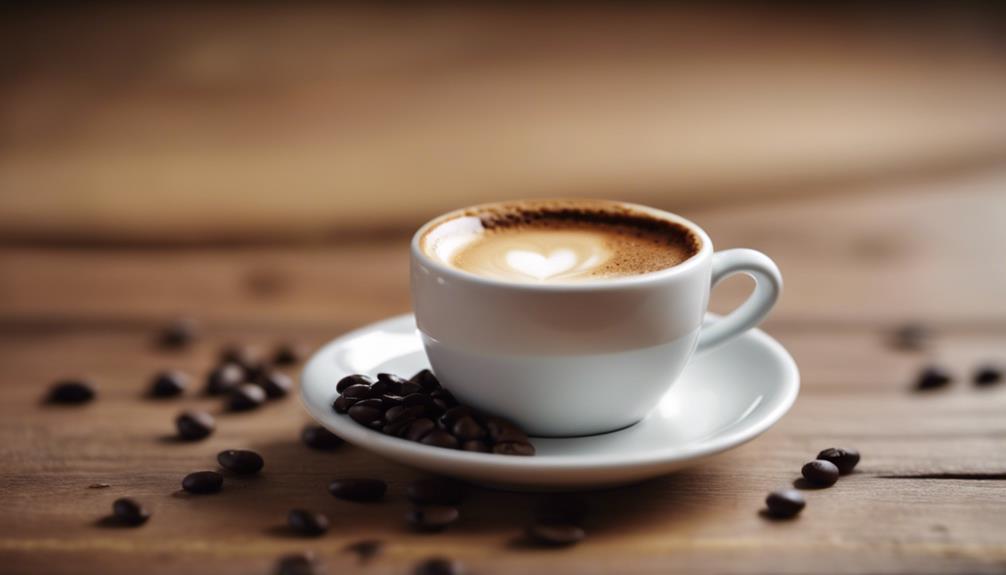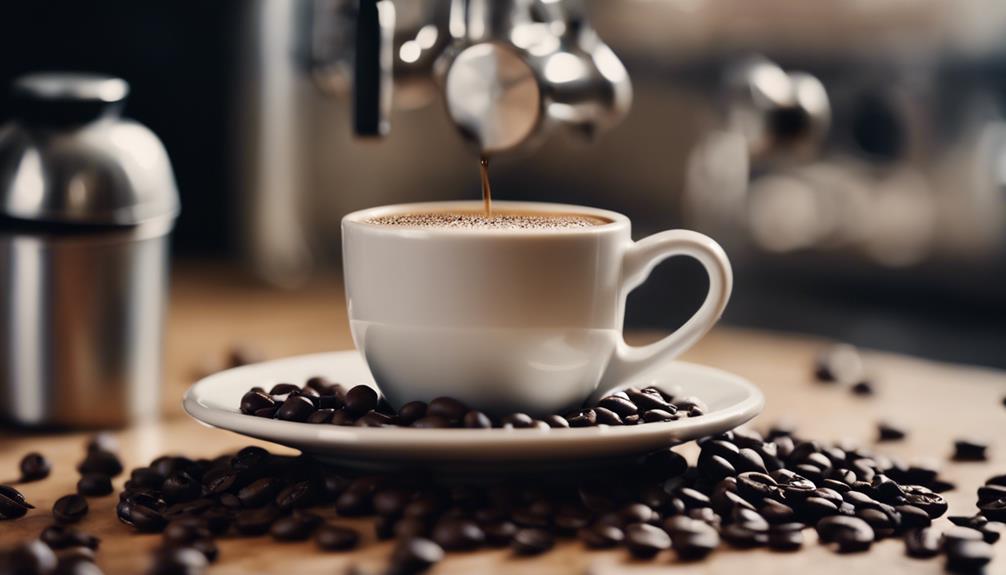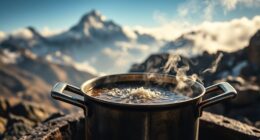You’re about to learn that a standard 1-ounce shot of espresso typically contains around 63 milligrams of caffeine, with double shots and popular espresso-based drinks having even more caffeine. This concentrated coffee has a stronger caffeine kick compared to brewed coffee, and factors such as the type of coffee bean, roast level, and brewing method can affect the caffeine content. As you delve into the world of espresso, you’ll see how these factors impact the caffeine in every cup, and what that means for your daily routine – but that’s just the beginning of the story.
Key Takeaways
- An average shot of espresso contains approximately 63 mg of caffeine, with a double shot having around 126 mg.
- Espresso has a higher concentration of caffeine compared to brewed coffee, with 63 mg per 1 ounce versus 95 mg per 8 ounces.
- Factors like coffee bean type, roast level, brewing method, and grind size can influence the caffeine content of espresso.
- Starbucks espresso contains 75 mg of caffeine per 0.75 ounces, while Pike Place coffee has 155 mg per 8 ounces.
Caffeine Content Comparison
When you compare the caffeine content of espresso to brewed coffee, you'll notice that a single shot of espresso packs a more concentrated punch, with approximately 63 mg of caffeine per 1 ounce. One could argue that the caffeine content in a single shot of espresso is roughly equivalent to a small cup of brewed coffee. However, it’s important to note that the actual amount of caffeine in an espresso shot can vary depending on factors such as the type of bean used and the brewing method. So, when asking “how much caffeine in espresso shot?”, it ultimately comes down to the specific circumstances of the coffee in question. It’s also worth considering that the caffeine content in espresso can be affected by the size of the shot, as well as the duration of the extraction process. Some coffee enthusiasts may prefer a longer or shorter extraction time to alter the flavor profile and caffeine content of the espresso. Ultimately, the caffeine content in espresso is just one factor to consider when enjoying this beloved beverage.
In contrast, an 8-ounce cup of brewed coffee typically contains around 96-128 mg of caffeine, averaging at 95 mg. This means that while a cup of brewed coffee has more caffeine overall, the amount of caffeine in a single espresso shot is more concentrated.
If you're familiar with Starbucks, you know that their espresso has a slightly higher caffeine content at 75 mg per 0.75 ounces, while their Pike Place coffee contains 155 mg per 8 ounces.
It's worth noting that a double shot of espresso, also known as a doppio, has about 126 mg of caffeine, roughly equivalent to the caffeine found in a standard 8-ounce cup of coffee.
The caffeine content in espresso can vary depending on the brewing methods and type of coffee beans used, but overall, espresso is a more concentrated source of caffeine than brewed coffee.
Factors Influencing Caffeine Levels
As you explore the world of espresso and coffee, you'll find that several factors influence the caffeine levels in your daily cup. The type of coffee bean, roast level, brewing method, and amount of coffee used all play a considerable role in determining the caffeine content in coffee.
| Factor | Influence on Caffeine | Description |
|---|---|---|
| Type of Coffee Bean | High | Robusta beans contain about twice as much caffeine as arabica beans |
| Roast Level | Medium | Lighter roasts retain slightly more caffeine than darker roasts |
| Brewing Method | High | Espresso extracts caffeine more efficiently than other methods |
| Amount of Coffee Used | High | Higher coffee doses yield more caffeine in the final beverage |
Additionally, environmental factors, such as growing conditions and altitude, can also impact the caffeine concentration in coffee beans. When it comes to espresso, the brewing method and amount of coffee used are particularly important, as they can considerably affect the caffeine per ounce. By understanding these factors, you can better appreciate the complexities of caffeine levels in espresso and coffee.
Perception of Caffeine Effects

You tend to feel the effects of espresso's caffeine more intensely due to its rapid consumption and higher concentration. When you down a shot of espresso, the caffeine hits your system quickly, giving you a more pronounced jolt compared to sipping regular coffee. This rapid consumption, combined with the higher concentration of caffeine in espresso (around 63 mg per ounce), contributes to its stronger perceived stimulatory effects.
However, your individual tolerance to caffeine also plays a significant role in how you experience its effects. If you're sensitive to caffeine, you may feel the effects more intensely, while those with a higher tolerance may not feel it as much.
Additionally, psychological factors like expectation and context can influence your sensitivity to caffeine, affecting your experience of its effects. The serving size of espresso, typically smaller than a cup of coffee, can also enhance the perceived effects of its caffeine.
As you enjoy your espresso, remember that it's not just the amount of caffeine that matters, but also how you consume it and your individual response to its effects. Consider factors such as how much caffeine in espresso shot you are consuming, your body’s tolerance to caffeine, and any other medications or substances you may be ingesting that could interact with caffeine. It’s important to be mindful of how your body reacts to caffeine and to moderate your intake accordingly. Additionally, consider the timing of your espresso consumption, as consuming caffeine too close to bedtime can disrupt your sleep patterns. Overall, enjoy your espresso, but do so in a way that is mindful of your individual needs and responses.
Health Recommendations
To guarantee a healthy and balanced relationship with espresso, it's vital to follow established guidelines for daily caffeine intake. The FDA recommends a safe daily caffeine limit of 400 mg, equivalent to about four cups of brewed coffee or six shots of espresso.
As a single shot of espresso contains approximately 63 mg of caffeine, you can enjoy it as a controlled caffeine choice. If you're looking to reduce your overall caffeine consumption, consider milk-based espresso drinks like lattes, which offer a similar experience with less caffeine per serving.
Regular espresso consumption, in moderation, may even offer health benefits like improved cognitive function and physical performance. However, it's important to be aware of your individual tolerance, as psychological factors can affect your perception of caffeine's effects.
Be mindful of your daily caffeine intake and adjust it according to your sensitivity. By doing so, you can reap the benefits of espresso while maintaining a healthy balance.
Coffee and Espresso Equipment

With a world of options available, selecting the right coffee and espresso equipment is vital for accessing the perfect brew, and Consumer Reports provides valuable insights to guide your purchase. You'll find various machines for making espresso, including traditional espresso machines, stovetop Moka pots, and portable espresso makers, each offering unique brewing experiences.
| Equipment Feature | Importance |
|---|---|
| Grind size | Critical for ideal extraction and flavor |
| Brewing equipment quality | Directly affects performance and brewing results |
| Maintenance | Regular cleaning and descaling prolong equipment lifespan |
| Espresso machine type | Impacts coffee experience and flavor profile |
Investing in high-quality brewing equipment can greatly enhance the flavor and overall coffee experience, according to user reviews that highlight performance and reliability. Proper equipment maintenance, including regular cleaning and descaling, is vital for maintaining performance and prolonging the lifespan of coffee and espresso machines. By considering these factors, you'll be well on your way to achieving the perfect brew and enjoying a superior coffee experience.
Espresso Basics and Preparation
Espresso's rich flavor and distinctive crema are achieved through a precise brewing process that involves forcing hot water through finely-ground coffee beans. When you brew a shot of espresso, you're creating a concentrated coffee beverage that's packed with flavor and caffeine. A standard shot is approximately 1 ounce, and you can expect it to contain around 63 mg of caffeine.
To get the finest flavor out of your espresso, it's crucial to pay attention to the brewing temperature and extraction time. The ideal temperature for espresso extraction is between 190°F to 205°F, with an extraction time of 25 to 30 seconds. This allows for peak flavor and aroma. You'll know you've got it right when you see a layer of golden crema on the surface of your espresso – it's a sign of a well-pulled shot.
You can experiment with different brewing methods to find your favorite way to make espresso. From traditional espresso machines to stovetop Moka pots and portable espresso makers, there's a brewing method out there for you. By mastering the basics of espresso preparation, you'll be well on your way to creating rich, flavorful shots that'll impress even the most discerning coffee lovers.
Caffeine in Espresso Drinks

Your average espresso drink at a coffee shop typically packs a caffeine punch that's worth understanding.
When you order a cappuccino or latte, you're likely getting 75 mg of caffeine for a short or tall size, and 150 mg for a grande or venti size, assuming a single shot of espresso.
However, if you opt for a mocha, the caffeine content can vary, ranging from 90 mg for a short or tall to 180 mg for a venti, thanks to the added chocolate.
If you prefer an Americano, the caffeine content depends on the number of shots used, with short sizes containing around 75 mg and venti sizes reaching up to 300 mg.
At Starbucks, a single shot of espresso contains approximately 75 mg of caffeine, while a double shot has about 150 mg.
When you add multiple shots to your drink, the total caffeine intake can increase considerably.
Be mindful of this when ordering, especially if you're sensitive to caffeine.
Frequently Asked Questions
How Much Caffeine Is in a Shot of Espresso Vs Coffee?
You're wondering how much caffeine is in a shot of espresso vs coffee. Well, a standard 1-ounce espresso shot has around 63mg of caffeine, while an 8-ounce cup of brewed coffee averages between 96-128mg.
Is 2 Shots of Espresso a Lot of Caffeine?
You'll be surprised to know that the FDA suggests a daily caffeine limit of 400 mg for healthy adults. Now, considering you're having two shots of espresso, that's around 126 mg of caffeine – not excessive, but still a moderate amount that may affect you depending on your sensitivity.
How Much Coffee Is in One Shot of Espresso?
You're wondering how much coffee is in one shot of espresso. Typically, you'll find around 7-9 grams of finely ground coffee beans in a standard 1-ounce shot, which is the perfect amount for a rich and concentrated coffee experience.
Why Is Espresso Stronger Than Coffee?
You're about to 'cut to the chase' and uncover the secret behind espresso's potency. Fundamentally, espresso's stronger than coffee because its unique brewing method, using finely-ground beans and high pressure, extracts caffeine more efficiently, resulting in a more concentrated dose.
Conclusion
Now that you've got the lowdown on caffeine in espresso, you're probably wondering – what's the perfect shot?
The answer lies in the delicate balance of roast, grind, and brewing technique.
But beware, a slight miscalculation can release a caffeine beast that'll leave you jittery and wide-eyed.
So, will you take the risk and aim for espresso nirvana, or play it safe and settle for a mediocre brew?
The choice is yours, but proceed with caution – your caffeine cravings are counting on it.









